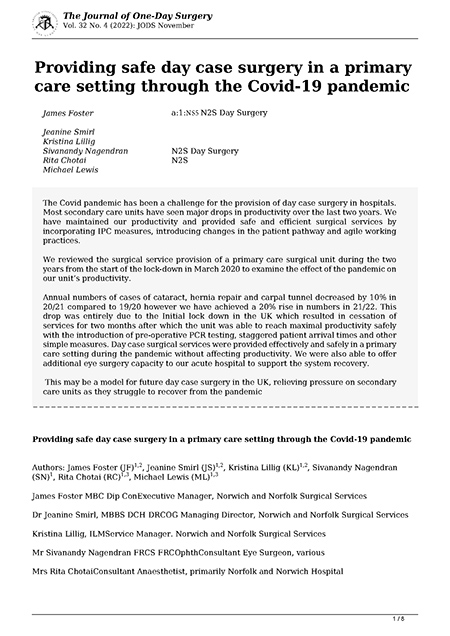Providing safe day case surgery in a primary care setting through the Covid-19 pandemic
Main Article Content
Abstract
Introduction
The Covid pandemic has been a challenge for the provision of day case surgery in hospitals. Most secondary care units have seen major drops in productivity over the last two years. We have maintained our productivity and provided safe and efficient surgical services by incorporating IPC measures, introducing changes in the patient pathway and agile working practices.
Methods
We reviewed the surgical service provision of a primary care surgical unit during the two years from the start of the lock-down in March 2020 to examine the effect of the pandemic on our unit’s productivity.
Annual numbers of cases of cataract, hernia repair and carpal tunnel decreased by 10% in 20/21 compared to 19/20 however we have achieved a 20% rise in numbers in 21/22. This drop was entirely due to the Initial lock down in the UK which resulted in cessation of services for two months after which the unit was able to reach maximal productivity safely with the introduction of pre-operative PCR testing, staggered patient arrival times and other simple measures.
Results
Day case surgical services were provided effectively and safely in a primary care setting during the pandemic without affecting productivity. We were also able to offer additional eye surgery capacity to our acute hospital to support the system recovery.
Conclusions
This may be a model for future day case surgery in the UK, relieving pressure on secondary care units as they struggle to recover from the pandemic. There is a room for best practice from community-based day surgery to be considered by larger institutions.
Downloads
Article Details
References
COVIDSurg Collaborative, Elective surgery cancellations due to the COVID-19 pandemic: global predictive modelling to inform surgical recovery plans. Br J Surg. 2020 Oct;107(11):1440-1449. doi: 10.1002/bjs.11746. Epub 2020 Jun 13. PMID: 32395848; PMCID: PMC7272903.
NHS England (internet), Consultant-led referral to treatment waiting times. https://www.england.nhs.uk/statistics/statistical-work-areas/rtt-waiting-times/rtt-data-2020-21/ (cited July 2022)
NHS England, Delivery Plan for tackling the COVID-19 backlog of elective care. https://www.england.nhs.uk/coronavirus/wp-content/uploads/sites/52/2022/02/C1466-delivery-plan-for-tackling-the-covid-19-backlog-of-elective-care.pdf (cited July 2022)
Lipp A, President’s Letter, Journal One-Day Surgery Volume 32, 2015.
Deming.org https://deming.org/explore/pdsa/ (cited July 2022).
Researchgate (cited July 2022), Leading Innovation Change – the Kotter way. https://www.researchgate.net/profile/Praveen-Gupta-17/publication/275461399_Leading_Innovation_Change_-_The_Kotter_Way/links/55aa771b08aea99467240eb1/Leading-Innovation-Change-The-Kotter-Way.pdf?_sg%5B0%5D=started_experiment_milestone&origin=journalDetail (cited July 2022)
Department of Health, Shifting Care Closer to Home demonstration sites – report of the speciality subgroups. DH. 23 Oct 2007. https://webarchive.nationalarchives.gov.uk/ukgwa/20130123192707/http://www.dh.gov.uk/en/Publicationsandstatistics/Publications/PublicationsPolicyAndGuidance/DH_079728 (Cited July 2022).


